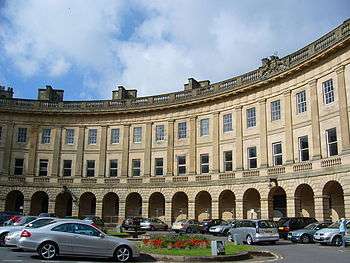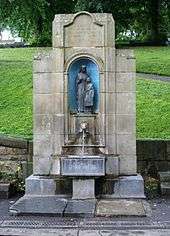Buxton Crescent
| Buxton Crescent | |
|---|---|
 Buxton Crescent | |
| General information | |
| Town or city | Buxton, Derbyshire |
| Country | England |
| Coordinates | 53°15′32″N 1°54′50″W / 53.259°N 1.914°WCoordinates: 53°15′32″N 1°54′50″W / 53.259°N 1.914°W |
| Construction started | 1780 |
| Completed | 1789 |
| Client | Fifth Duke of Devonshire |
| Design and construction | |
| Architect | John Carr |
Buxton Crescent is a Grade-I-listed building in the town of Buxton, Derbyshire, England.[1] Owing much to the Royal Crescent in Bath, but described by the Royal Institution of British Architects as "more richly decorated and altogether more complex",[2] it was designed by the architect John Carr, and built for the Fifth Duke of Devonshire between 1780 and 1789.[1]
Location



The Crescent faces the site of St Ann's Well, where warm spring water has flowed for thousands of years. The well is at the foot of The Slopes, a steep landscaped hillside in the centre of Buxton. Here the geological strata channel mineral water from a mile below ground, to emerge at a constant 27.5 °C (81.5 °F).[3][4][5]
Current setting
Originally detached, the Crescent building is now the centrepiece of an attached range facing The Slopes.[3][6]
- To the left (southwest) are the Natural Mineral Baths (Grade II listed, 1851–53, by Henry Currey), recently the tourist office but now empty; followed by the Old Hall Hotel (1572, altered 1672, rebuilt 1725–35, listed Grade II*), and still a hotel.
- To the right (northeast) are the Buxton Thermal Baths, now shops; and The Colonnade, a row of shops with a projecting canopy (both Grade II listed, 1851–53, also by Currey).
- Across the forecourt of the Crescent, at the foot of The Slopes, are the Pump Room (1894, also by Currey); and the adjacent public drinking spout St Ann's Well, built c.1940, on the site of earlier wells dating back to the Roman period.
Original construction and use
The Crescent was built for William Cavendish, the 5th Duke of Devonshire, as part of his scheme to establish Buxton as a fashionable Georgian spa town.[7]
The facade forms an arc of a circle facing southeast. It was built as a unified structure incorporating a hotel, five lodging houses, and a grand assembly room with a fine painted ceiling.[1] The Assembly Rooms became the social heart of 18th-century Buxton.[7]
On the ground floor arcade were shops (including a hair and wig-dresser) and kitchens were in the basement.[7]
Subsequent history
Over time, St. Ann's Hotel at the western end of the Crescent, and the Great Hotel, incorporating the Assembly Rooms at the eastern end, took over the intervening lodging houses in the centre of the building.[7]
Twentieth century
The western end served as a hotel. The eastern end served as council offices, a library and a clinic.[8] The hotel at the western end closed in the mid-1980s due to the high cost of necessary repairs. The whole building was closed when major structural problems were discovered in the assembly rooms, and by 1992 lay empty.[8] The hotel part was bought by the local council in 1993, at which time the whole building fell into public ownership.[8]
Current developments
In 1993 with a grant from the National Heritage Memorial Fund the High Peak Borough Council purchased the Crescent to act as a temporary caretaker of the building until a suitable buyer could be found. A further £1.5 million from English Heritage was used to make the building weathertight.[9]
The Crescent, Pump Rooms and Natural Baths buildings were then jointly marketed by the borough and county councils. In 1994 the Monumental Trust proposed a scheme to convert the Crescent into flats; however, no funding was found. In December 2000 the combined councils applied to the Heritage Lottery Fund to help finance plans to restore the Crescent as a hotel and to build new spa facilities. Funding was approved in July 2003.[9]
Work to restore, redevelop and manage the hotel and spa was put out to tender, which was won in December 2003 by a partnership of the Trevor Osborne Property Group Limited and CP Holdings Limited, the parent company of the spa hotel specialists Danubius hotels. The then £23 million plan was scheduled for completion in 2007.[10]
However the project suffered a series of delays, including funding and technical and legal issues relating to the continued supply of water from springs beneath the buildings to Nestlé, the bottler of Buxton Water,[11] and it was not until April 2012 that an agreement between the joint councils and the developer to start the first phase of the project could be signed.[12] Phase one work on the then £35 million project for a 79-bedroom 5-star hotel, natural baths, a visitor interpretation centre, a thermal mineral water spa and specialist shops commenced in the summer of 2012.[13] Funding problems delayed the main part of project further, but with a loan guarantee from Derbyshire County Council and an additional grant of £11.3 million from the Heritage Lottery Fund announced in 2014, work is expected to resume in 2015. A further £2 million is still required for the £46 million development.[14][15]
References
- 1 2 3 Historic England. "The Crescent (1257876)". National Heritage List for England. Retrieved 7 February 2014.
- ↑ "the Crescent, Buxton". Palladio and Britain. Royal Institution of British Architects. Retrieved 17 September 2011.
- 1 2 Historic England. "The Slopes, Buxton (1001456)". National Heritage List for England. Retrieved 7 February 2014.
- ↑ "Our water: Purified naturally". Buxton Water. Retrieved 17 September 2011.
- ↑ "Our Brands: Buxton Mineral Water". Nestle UK. Archived from the original on 28 September 2011. Retrieved 17 September 2011.
- ↑ "Map Search". The National Heritage List for England. English Heritage. Archived from the original on 24 April 2012. Retrieved 17 September 2011.
- 1 2 3 4 "The Crescent: Take a look inside John Carr's Grade 1 Listed Gem". Visit Buxton. Retrieved 18 September 2011.
- 1 2 3 Ward, David (5 January 2004). "Spa revives hope for Buxton crescent's faded glory | Culture". The Guardian. Retrieved 14 September 2011.
- 1 2 "Treasured jewel of our spa town". Buxton Advertiser. 4 December 2003. Retrieved 7 February 2014.
- ↑ "Spa hotel plans at the Crescent". Buxton Advertiser. 4 December 2003. Retrieved 7 February 2014.
- ↑ "Delay for Buxton Crescent project". BBC News. 23 June 2009. Retrieved 7 February 2014.
- ↑ "Historic agreement paves way for Crescent development". High Peak Borough Council. 2 April 2012. Retrieved 7 February 2014.
- ↑ "Public meeting to hear about Crescent development scheme". Buxton Advertiser. 27 July 2012. Retrieved 7 February 2014.
- ↑ "Crescent opening is delayed until 2016". Buxton Advertiser. 7 February 2014. Retrieved 7 February 2014.
- ↑ "Heritage Lottery Fund agrees additional £11.3m grant towards Buxton Crescent hotel development". Buxton Advertiser. 21 November 2014. Retrieved 22 November 2014.
External links
- High Peak Council Press Release
- English Heritage listing
- Article with picture of Assembly Room ceiling Visit Buxton
- Article with Image of Buxton Crescent in 1795 Royal Institute of British Architects
- Newsletter of the regeneration project Buxton Crescent Hotel & Thermal Spa
- Articles with photo galleries of CrescentCrescent HotelsPump Room iPeak
